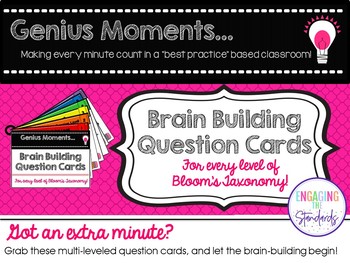Genius Moments: Brain Building Question Cards (All Levels of Bloom's Taxonomy)
- PDF
Description
“Genius Moments” Tool:
Brain Building Question Cards
{For every level of Bloom’s Taxonomy}
Grab these cards when you have a few extra minutes in your classroom to “fill!” Don’t waste one single minute of classroom time. Turn those extra, unplanned moments into GENIUS MOMENTS!
Simply grab your “ring” of Brain Building Question Cards and read a card aloud to the class. You may choose to have students answer you individually, turn to a partner and pair-share or turn-and-talk, or work within a small group to share answers and discuss the given question.
Includes:
* A flip card cover and 20 question cards for each of the six different levels of Bloom's Taxonomy for a total of 120 multi-leveled question cards.
* These cards are not just "question starters" or "question stems." They are ready to read questions that are appropriate for any lower elementary grade, and can be used any day of the year!
* Editable multi-leveled question cards so you can add your own questions!
_________________
Additional Info:
What are “Genius Moments?”
In my classroom, I refer to the unexpected “extra moments” that I find within my schedule as Genius Moments! You know what I mean…the 3 minutes you have before recess time…or the 4 extra minutes you have because your kiddos finished their center rotations early. If you are like me, you don’t want to waste one single minute of classroom instructional time! That is why I created a collection of “genius moment” resources, all based on best practices, that can be grabbed and used in a flash! I turn those extra, unplanned moments into GENIUS MOMENTS! I’m excited to get my first one posted on TPT to share with you! I’m working on getting the rest of them posted very soon! Stay tuned!
Genius Moments are all based on research based “best practices!”
Research shows that there are some instructional strategies that, by their very nature, result in improved learning success for students. These strategies have come to be known as “best practices.” These strategies are so effective, according to research, because…
They increase academic achievement for ALL students, including special education, ESL and gifted learners.
They decrease behavior challenges/problems by more actively engaging learners and increasing student confidence.
They make teaching and learning FUN!
They can be used in any classroom, at any grade level.
What is Bloom’s Taxonomy?
Bloom's Taxonomy was created in 1956 under the leadership of educational psychologist Dr. Benjamin Bloom in order to promote higher forms of thinking in education, such as analyzing and evaluating concepts, processes, procedures, and principles, rather than just remembering facts (rote learning). It is a way to classify thinking into multiple cognitive levels of complexity. Bloom’s model consists of six levels, with the three lower levels (remembering, understanding, applying) being more basic than the higher levels (analyzing, evaluating, creating). Some think of the levels as a stairway, in which learners are encouraged to achieve a higher level of thinking.
Why Is It Important For Us To Learn About Bloom’s Taxonomy?
It helps your brain grow stronger!
Research shows that the critical thinking ability developed through using the higher-level thinking skills of Bloom’s Taxonomy “strengthens thebrain—creating more synapses between nerve cells—just as exercise builds muscle tissue.” (http://www.ascd.org/publications/educational-leadership/mar97/vol54/num06/Seven-Strategies-That-Encourage-Neural-Branching.asp)
“Higher ordering thinking skills…help learners make connections between past and new learning, creates new pathways, strengthens existing pathways, and increases the likelihood that the new learning will be consolidated and stored for future retrieval.” (How The Brain Learns, 3rd Edition, by David A. Sousa)
Higher level questioning helps students develop skills employers are looking for. Survey after survey shows that employers are looking to hire people who have the critical thinking skills demonstrated in the higher-levels of Bloom’s Taxonomy (revised). They specifically say they want “problem-solving skills rather than memorization of coursework.” (http://psy1.clarion.edu/jms/qualifications.html)
Happy Learning!
Holly
Engaging the Standards





